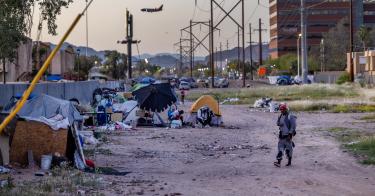Homelessness is not a constitutionally protected status, the Supreme Court ruled on Friday. The case, Grants Pass v. Johnson, examined whether it is constitutional to penalize the homeless for camping on public property. The court’s decision ultimately means there is no right-to-shelter provision in the Constitution and that city leaders have the authority to determine how city property is used.
This decision comes amid years of surging homelessness across the country. We often hear about the masses of people languishing on the streets in places like Los Angeles, San Francisco, and New York City. But even outside coastal, left-wing enclaves, homelessness has climbed, and the problem demands better responses than the failed liberal policies.
During the COVID pandemic, Arizona saw some of the highest increases in homelessness in the U.S. The problem has not abated. Between 2018 and 2023, homelessness in the state climbed by more than 40 percent, reaching its highest level in a decade. The number of people living on the streets in Pima County alone during this time more than tripled, while the number in Maricopa County grew by nearly 90 percent.
These eye-popping numbers are accompanied by the state’s spending large amounts on homelessness. An investigation by the Goldwater Institute found that between 2021 and 2024, the City of Phoenix, Arizona’s largest city, spent roughly $180 million on homelessness services (combined state, federal, and local dollars). Tucson, the second-largest city, is spending at least $50 million to $70 million on homelessness programs annually. The researchers say it’s unclear where all the money is going, since the cities have accounted for only a fraction of it.
>>> How To Solve Our Soaring Homelessness Problem
Despite that, Arizona activists are doubling down. The Tucson Pima Collaboration to End Homelessness says even more money is needed to tackle homelessness, at least twice as much as Tucson is currently spending. The solution, they say, is to build more government-funded housing for the homeless.
However, countless examples prove that focusing on housing, particularly permanent housing, is a failed approach and shouldn’t be the core focus of Arizona’s homelessness strategy. Policies to help the homeless should instead target the underlying causes of poverty and focus on helping people gain upward mobility. For many living on the streets, this means addressing challenges such as mental illness, substance abuse, family breakdown, and limited job skills.
For roughly two decades, the federal government has incentivized states to focus heavily on permanent housing as a solution to homelessness. Specifically, to provide permanent housing without conditions. This means no expectations that people maintain sobriety or participate in drug rehabilitation, engage in mental-health treatment, or find employment or receive job training.
It may not be surprising, then, that this “housing-first” approach, as it is called, fails to improve outcomes like drug abuse, mental illness, and unemployment, or that it is very costly. Housing-first also fails to reduce homelessness rates, possibly because it incentivizes people to remain homeless longer than they otherwise would in order to receive permanent housing or because it brings in people who would otherwise find housing elsewhere, such as with friends or family.
Yes, people need shelter, but the overarching goal should be to help them improve their self-sufficiency rather than to stay in government housing permanently.
So, what can Arizona do to effectively address homelessness?
Policies that provide temporary shelter and pair it with expectations that people participate in programs like mental-health treatment, drug rehabilitation, and job training encourage upward mobility while also addressing immediate temporal needs. These types of programs are associated with improved well-being, such as decreased drug use and better mental health.
>>> Open Borders Creating Bidenvilles of Homelessness. Who Saw That Coming?
One such example is the Birmingham Model. It provides people with a private unit while requiring recipients to abstain from alcohol and drugs. If a person fails to remain sober, they are moved to a spot in a shelter. They can work toward regaining the private unit by staying sober for a week.
Many people on the streets suffer from severe mental illness and could benefit from institutionalized or supervised outpatient care. There is a severe shortage of public psychiatric beds in the U.S., though. Increasing the availability of psychiatric care, implementing assisted outpatient treatment, and reviewing involuntary-commitment laws to see that people are able to be admitted for treatment are needed to address mental illness.
Cities should also maintain order on their streets and in other public areas. Tent encampments are often rife with drug use and unsanitary conditions, unhealthy for the individuals languishing there as well as for those in the surrounding community. City leaders are responsible for ensuring that public areas are safe and useable for the public and should not let their streets descend into chaos.
Arizona has spent a great deal on homelessness. To avoid getting caught in the cycle of ever-spending but failing to see improvements, leaders must get the policy right. In the case of homelessness, this means avoiding the notion that housing-first is the solution and instead focusing on underlying human needs so people can reconnect with their communities and truly find home.
This piece originally appeared in the National Review




